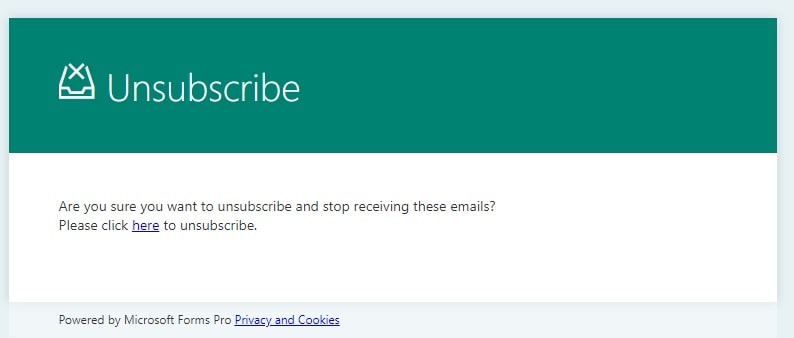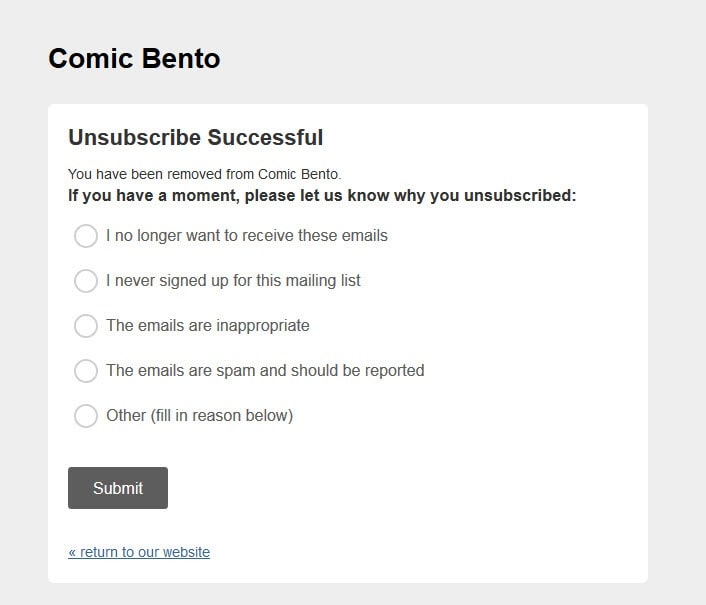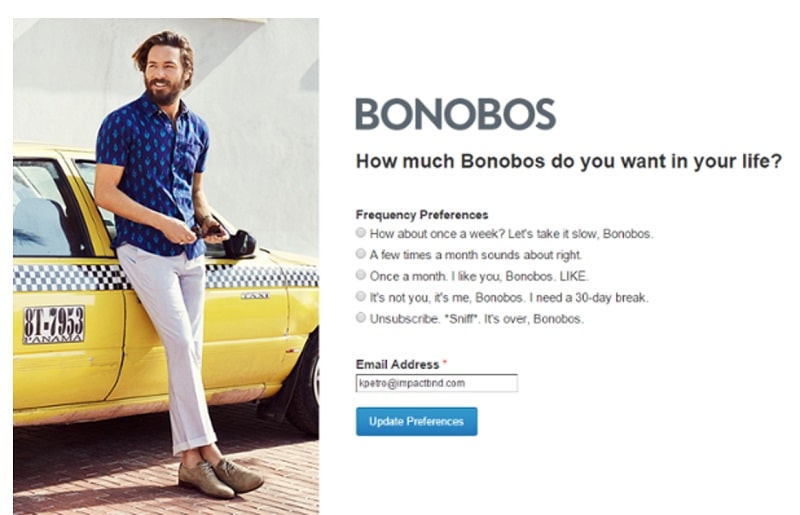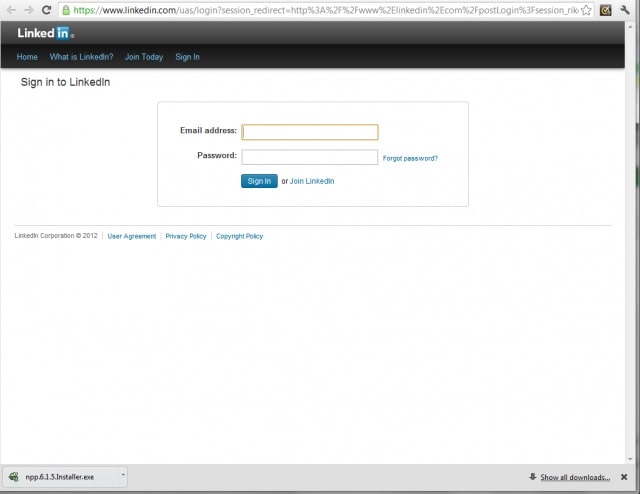Recent studies show that nearly 70% of businesses use email as part of their overall marketing strategy – an unsurprising statistic since email is such an effective channel.
But it does come with its own set of challenges. One particularly rampant problem is that of unsubscribes.
Although it’s a natural part of the process, it’s hard to see people opting out of receiving your emails – especially after you worked so hard to build your list.
Luckily, there are some things you can do to lower your unsubscribe rate.
One way is by creating a compelling unsubscribe page that will make it hard for users to want to unsubscribe from your list.
A well-designed page will also provide you with important feedback that you can implement for better success in the future.
Without further ado, here are 7 tips to make unsubscribe pages work for you.
1. Avoid Accidental Unsubscribes

Avoid using one-click unsubscribe buttons as these can result in accidental removals of subscribers from your list.
Whenever a reader scrolls to the bottom of one of your email messages and hits the “unsubscribe” button, they must be taken to an unsubscribe confirmation page where they can confirm the cancellation before being taken off your email list.
If you don’t do that, some readers may accidentally hit the unsubscribe link, and you would lose them, possibly forever.
Other times, readers click the unsubscribe link to see what their options are if they are thinking about opting out of your list.
But, since not everyone who clicks the link actually intends to leave, it’s never a good idea to have a one-click unsubscribe button because there will be no way for readers to undo the action.
2. Get Feedback on Why They Are Unsubscribing
There are many reasons why people might choose to unsubscribe from your email list. For instance:
- They may need a break
- Maybe they changed their email address
- They might be getting too many emails each day
- They may no longer be interested in the topic
…and many more.
Whatever the reason, you can use their unsubscribe as a way to improve your future campaigns and reduce the risk of more people leaving by providing an option on the unsubscribe page for feedback on why they are opting out of your email list.
Just like how a call to action works, guiding people to land on the targeted page easily, you must never make it hard for the reader to unsubscribe from your list when clicking the button. If they don’t want to provide feedback, they should still be able to unsubscribe at any time easily.
Don’t make it a requirement for unsubscribing. You should include the form for feedback _after _the reader has successfully unsubscribed.
Also, don’t turn it into a lengthy survey or poll, as this can chase busy readers away if they have to sift through many different choices or answer questions to provide feedback.
A simple survey on your email unsubscribe confirmation page with a limited number of options (ideally 3 – 5 options) will suffice, and it will help you collect valuable information on why people want to unsubscribe from your list.
Here’s an example of that kind of short survey from Comic Bento:

The more feedback and other data you get when they unsubscribe, the better. When practicing proper channel management, you want to make sure you have all the data you can possibly have about all of your channels of communication with your customers and brand ambassadors. What you learn from an unsubscriber today may be what prevents another unsubscribe in the future.
3. Use a Friendly and Humorous Tone

Even while readers are in the process of bidding you goodbye, you can still find ways to increase the likelihood that they will stay and possibly even resubscribe in the future.
When you use a friendly and humorous tone on your unsubscribe page, you ensure that readers don’t leave with a negative impression of your business or brand, and it helps you make it so they feel welcome to come back in the future.
Even if they are not interested in being on your list, they may still find your content engaging and useful.
So make sure your language and tone make it clear to readers that they are welcome to return to your website or social profiles at any time.
Whenever appropriate, use humor to grab the user’s attention and motivate them to take the desired action. Just keep in mind that humor is subjective, so be _very _careful when selecting jokes or funny memes and videos for your unsubscribe page.
4. Add a Personal Goodbye
Yet another effective way to reduce your unsubscribes is to add a personal goodbye. This way, you can turn a potential unsubscribe request into an opportunity to build an even stronger relationship with your subscribers.
One of the worst things you can do on your unsubscribe page is to have a cold or unfriendly message like this one:

There’s never a reason to let subscribers go without even a word of thanks. And in fact, as shown by the tips in this article, an unsubscribe page is valuable real estate that will net you a ton of benefits – if you only know how to make full use of it.
Readers are less likely to forget you when you can show some personality. So make sure you’re friendly and gracious when saying goodbye and part ways with style so people can remember you.
Here’s an example from Hubspot, which uses humor on their unsubscribe page, making it highly entertaining and a great reminder of why they loved the brand in the first place.
In the video, Dan Sally, from the marketing department talks about the subscriber who’s leaving as if it’s an actual romantic breakup:
Alternatively, you can use a simple text message with a positive context. Or, you might consider using a charismatic GIF or image.
You could also use brand fonts and colors or anything else that helps to promote your brand identity so that they will remember your organization even after unsubscribing from your list.
5. Include Branding and Social Profiles

In addition to using the unsubscribe process to strengthen your relationship with your audience, you can also use it as a way to reinforce brand identity _and _guide leads towards other channels, such as your website and social media.
Reinforcing Brand Identity:
Remember, your customers’ journey goes a lot further than simply subscribing and unsubscribing to your emails.
And just because someone decides to remove themselves from your email list doesn’t mean you should give up caring about giving them a great user experience.
Your unsubscribe page gives you one last chance to show users that you still care while reinforcing your brand reputation and authenticity.
Just saying goodbye is not going to make them rethink their decision to unsubscribe. Send them a meme or use graphic design tools to create branded logos and images that your customers will remember. Make them want to stay by showing them that you really do have something unique and engaging to offer.
There are many ways you can use to reflect your organization’s corporate identity, such as
- Designing a page that looks original and is aligned with your brand identity
- Personalizing your unsubscribe page
- Thanking the user for the time you had together
…and so on.
Sending Leads to Other Channels:
Even though someone has unsubscribed from your newsletters, they may still want to hear from you on different channels that don’t involve email.
Make sure your unsubscribe page offers them a variety of other possibilities for staying in touch with you.
For instance, you might add the following:
- Social media buttons
- Links to relevant landing pages
- Links to your community
- Links to your website
… and so on
You can even use compelling text to make readers rethink opting out and help motivate them to connect with you on their preferred channel.
6. Offer a Frequency Downgrade
One of the reasons people unsubscribe is that they receive too many emails every day.
Give those who may still want to hear from you the opportunity to reduce the frequency with which they receive your emails, and more people will choose to stay on and receive fewer emails rather than unsubscribing.
Here’s an example of a brand that gives readers the chance to receive email messages less often:

This unsubscribe page works well because it pairs a friendly message with an appealing image and alternatives.
Together, these elements make it more likely that interested readers will remain subscribed.
Even if they opt to leave anyway, this type of page makes a warm and lasting impression on your subscribers. If they remember you fondly, they are more likely to return to read your content or possibly even resubscribe in the future.
Note: As an alternative to the frequency downgrade, you might also offer to personalize their subscription by using different categories on the unsubscribe confirmation page or in your email footer. When subscribers can tailor their newsletter to match their preferences, it increases the chances that they’ll stay on your list longer.
7. Don’t Make Subscribers Log in to Opt-Out

People shouldn’t have to log in to your site to unsubscribe from your list. While Linkedin has since changed this process, early on they required this of email subscribers. Forcing them to do so is a quick way to get your emails marked as spam.
Some may not remember their login information. Others simply may not have the time to fill in the form – either way, for most people, the alternative will be to tag your email address as “spam” to stop receiving your emails.
If many of your emails are marked as spam, it will significantly harm your email deliverability rates.
Email providers are always on the lookout for these types of spam reports, and if you are flagged as an offender regularly, it increases the chances of more of your future correspondence winding up in the spam folders of your subscribers’ inboxes.
Just because someone wants to unsubscribe from your emails does not mean they will never re-subscribe or become a customer again. You don’t want to burn bridges, and you don’t want to make the unsubscribing process so tricky that they form an unfavorable opinion about your business. If they are determined to unsubscribe, show them respect for their decision – that will prop the door open for a potential return to your business down the road.
- Carter Seuthe, CEO, Credit Summit
So, take the time to ensure that you make it as easy as possible for people to unsubscribe. Make sure they don’t have to log in or fill in any lengthy forms just to stop receiving your emails.
And use the other tips outlined above, such as using friendly, humorous language, adding a personal goodbye, and providing options for feedback on why they’re leaving. You’ll reduce not only your unsubscribe rate but also increase the number of people who re-subscribe to your email list.
8. Don’t Send Unsubscribe Confirmations by Email
Once someone has made it clear to you that they no longer want to receive your messages, don’t respond with yet another email. Otherwise, you run the risk of annoying the recipients and wasting all the efforts you had put in the first place for collecting emails, and you are also intentionally inviting “marked as spam.” So please don’t send unsubscribe confirmations by email.
Simply add the confirmation on the page as soon as the subscriber has been removed from the list.
You might even add a link to immediately re-subscribe if they have second thoughts, as in the example below from Puma:

Bonus Tip: Automate Your Email Marketing Strategy
When creating an email marketing strategy, it is prudent to use one of the best email marketing services to ensure that the right emails are sent at the right time. One key feature to look out for when selecting a service is whether it allows you to pause individual campaigns.
Ensuring that this process is automated is a must. When a user clicks unsubscribe, you don’t have time to put in the manual labor of removing someone from your email list. It might not seem like a major task, but that time adds up over time. And that’s time you could be spending on other projects or with your family.
So always look for email marketing services that offer automated unsubscribe features that can be integrated into your website and other digital channels.
Related Content
- 7 Tips To Reduce Email List Opt-Outs And Retain Your Subscribers
- 7 Ways to Engage Your Email List and Reduce Your Unsubscribes
- 13 Effective Ways To Optimize Your Newsletter
- Email Marketing Checklist: 18 Things to Check Before You Hit ‘Send’
- 5 Ways to Engage Email Subscribers that Won’t Be Ignored
Conclusion
Unsubscribe pages offer a huge opportunity to change readers’ minds who are ready to say goodbye and make the parting experience a friendly and memorable one.
In review, here are the 9 tips to help you make better unsubscribe pages;
- Avoid Accidental Unsubscribes
- Get Feedback on Why They Are Unsubscribing
- Use a Friendly and Humorous Tone
- Add a Personal Goodbye
- Include Branding and Social Profiles
- Offer a Frequency Downgrade
- Don’t Make Subscribers Log in to Opt-Out
- Don’t Send Unsubscribe Confirmations by Email
- (Bonus) Automate Your Email Marketing Strategy
Now that you’ve seen some of the many ways you can use your unsubscribe pages to turn lemons into lemonade, it’s time to put these tips to use to make your unsubscribe pages work for you.
Are you using any of the tips mentioned in this article? Or do you have other effective ways to get the most from your unsubscribe pages? Let us know in the comments section below!

Written by our guest writer Ron Stefanski, OneHourProfessor.com
Ron is an online entrepreneur with a portfolio of websites that generates millions of views yearly who has a passion for helping people create and market their own online business.



